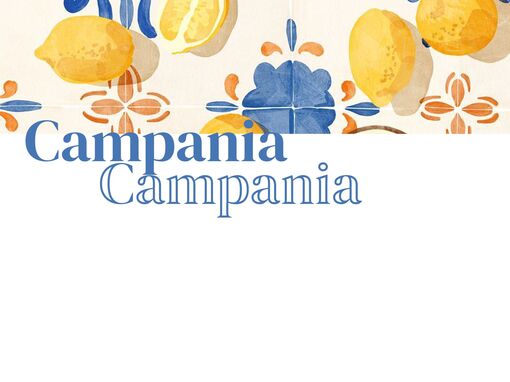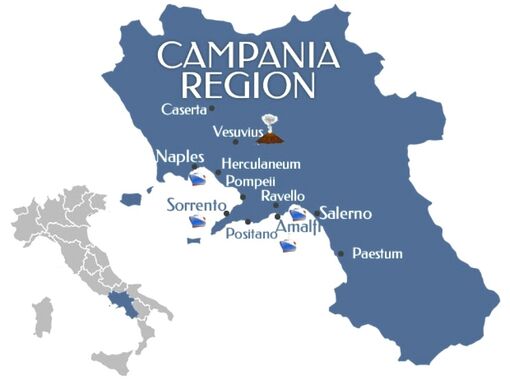
Elena & Michele
Elena & Michele
The Campania Region

The Campania region is situated in the South of Italy and outlined on the west by the Mediterranean Sea (called the Tyrrhenian, or Tirreno in Italian). The region is the gateway to the south and has been enjoyed as a vacation spot since ancient times.
The region is divided into five provinces: Salerno, Caserta, Avellino, Benevento and Naples (Napoli). Naples is also the capital city of the region itself.
With roughly 6 million residents, half of which live around the city of Naples, Campania has more people than the nation of Finland, packed in an area that is 200 times smaller! But despite its population density, there are still some wild and unknown areas, with mountains and small towns to enjoy, too. Its seacoast is Italy's most famous and fabled – who hasn't heard of the Amalfi Coast?

History
Campania was settled by Greek immigrants in the 8th Century BC, forming the first colony of Magna Grecia at Cuma. Over the centuries, both the Etruscans and the Samnites occupied portions of Campania before being absorbed by Rome. Byzantine and Lombard armies fought each other for control of Campania, but in the end, most of the major areas including Naples and Benevento became independent city-states.
The coastal area of Amalfi became a maritime power during the Middle Ages and at the same time Norman adventurers arrived and took over much of Campania. These holdings would begin the 700-year history of the Kingdom of Naples, which went from French Norman hands to German Hohenstaufen back to the French Angevins before being acquired by the Spanish house of Aragon. The house of Bourbon held the Kingdom of Naples until the time of Napoleon when it was ruled by Joseph Bonaparte. Garibaldi’s arrival in Naples in 1860 signaled the end of the Kingdom of Naples and the beginnings of the new Italian nation.
Sights and attractions
Campania is for lovers of archeology and architecture. The archeological heritage here is huge: including the splendid temples left by the Greeks in Paestum, the buried towns of Pompeii and Herculaneum, the remains of Greco-Roman Velia, and the second-largest Roman amphitheater in Italy at Capua. Museums, churches, piazzas, and palaces – you'll be amazed by the variety and beauty of the architecture here.
But if you prefer the beauty of nature, Campania won't disappoint you with its natural parks, sandy beaches, and crystal-clear waters. The awe-inspiring scenery of the famous Amalfi Coast, and the islands of the Gulf of Naples (Capri, Ischia, and Procida) are just a few of the places you can enjoy.
Food
The food of Campania is in many ways the food of Italy. So many of the dishes that are native to Campania have been adopted by the rest of Italy, if not the world. Italian food would not be the same without Campania’s Spaghetti with Pommarola, the famous tomato sauce.
Campania is also the birthplace of modern pizza, with the world’s first pizzeria (still in business) started on the streets of Naples. The cooks of Campania were the first to use tomatoes, debunking the once-common myth of their deadliness. The volcanic soils of Campania grow some of the best produce in Italy, including the San Marzano tomatoes (DOP), whose deep red color and rich flavor are popular for making sauces. Campania is also known for its fruit orchards ranging from its famous peaches and grapes to apricots, figs, oranges, and lemons.
Campania’s most famous cheese is the Mozzarella di Bufala Campana (DOP), made from the milk of local water buffalos and gracing such favorites as pizza Margherita and insalata caprese. Other popular cheeses include sheep’s milk Pecorino, Scamorza, Ricotta (both cow and buffalo versions), and Mascarpone. Parmigiano Reggiano has also found its way into the recipes of Campania, with vegetable dishes served “alla Parmigiana”.
Seafood is a staple of Campania’s coastline with fish fried in olive oil a favorite of Naples, while other specialties make use of local octopus, cuttlefish, squid, clams, and mussels. Campania’s desserts range from local fresh fruit to honey-glazed Struffoli puffs to the famously decadent Zeppole, traditionally served on St. Joseph’s Day in March.
Wine & Spirits
The wines of Campania have a truly ancient pedigree, with many types dating back to the early Greek colonists and praised by the Romans. Other varieties have been revamped with modern wine-making techniques, making Campania wines once again sought after outside of Italy. The standout red of Campania is Taurasi (DOCG), a dry, aromatic wine that is best when aged and has not changed its character in two thousand years. The Vesuvio wines take on the traits of the rich soil from the slopes of the volcano and come in red, milder Rosso, and the fragrant Bianco varieties.
Also from the Vesuvius area is the cryptically named white, Lacryma Christi, or tears of Christ. However, the most famous wine of Campania is also the oldest, the Greco di Tufo (DOCG), which arrived with the first Greek settlers.
Several famous spirits come from Campania, including Capri’s Limoncello, made from the island’s thick-skinned lemons. Nocillo is a walnut-infused liqueur made in the Vesuvius area and prized as a digestivo. Benevento is the home of the golden herb-infused Strega, which often lends its flavor to desserts or is sipped after a meal.
Casertavecchia

Casertavecchia or “old Caserta” is the former medieval village of Caserta, which was founded in 861 AD and is located on top of the mountains.
This is where we will be hosting our ceremony, reception, and two nights of accommodations (Saturday – Monday).
Casertavecchia is around 30 minutes driving from Caserta (or Portico di Caserta) and 1 hour driving from Naples International Airport.
Casertavecchia, a medieval village that rises on the slopes of the Tifatini mountains, is considered one of the most important Italian national monuments. Rich in history and with an important past of dominations (Longobards, Saracens, Normans, Aragonese and Bourbons) the atmosphere that can be felt while walking through the narrow streets and the remains of ancient walls is unique: the remains of the castle and its routes allow you to relive the splendor of times gone by. The splendid panorama can be enjoyed in many points of the village. That’s a perfect combination for a holiday between culture and relaxation.
Caserta

Caserta is the capital of the homonymous province of Campania. The city is best known for the 18th-century Bourbon Royal Palace of Caserta (a UNESCO World Heritage Site).
Caserta connects well to Naples, the southern Italian coast, and many other major cities within Italy by regional or fast-speed trains through its centrally-located train station and is around 45 minutes driving from Naples International Airport.
This is where we'd recommend to friends and family to base themselves if they’d like to stay longer than just the long weekend for the ceremony.
The Royal Palace of Caserta and its park (Parco Reale, Royal Gardens) have been a UNESCO heritage site since 1997. Designed in the eighteenth century by Luigi Vanvitelli, and commissioned by Charles III of Bourbon, the Palace is a jewel of unparalleled splendor. With great attention to detail, it embodies the triumph of Italian Baroque: it is divided into four monumental courtyards, from which a spectacular park is born, composed of fountains and waterfalls. It's huge, covering an area of 47,000 square meters, making it the largest former royal residence in the world (much bigger than Versailles).
Experience Caserta at its best, and get to know the thousand facets of the city: stroll through the city's historical center to discover the most beautiful and elegant shop windows, with countless clothing shops, typical products, bars, fast food outlets, and trendy venues to spend a few hours. Visit the center: Corso Trieste, Via Mazzini, Via Ferrante, Piazza Vanvitelli are just some of the most “in” places in the city.
Naples

Naples is Campania's regional capital and Italy's third-largest city, after Rome and Milan. It is a wild and fascinating city and a living lesson in contrasts – it is historic, musical, energetic, chaotic, gritty, and noisy at the same time.
The Bay of Naples and the looming figure of Mount Vesuvius make Naples a city rich with natural views and historical sites. Neapolitan cuisine is noted for its association with pizza, which originated in the city, and numerous other local dishes.
For centuries, Naples was passed from empire to empire and civilization to civilization. Greek, Roman, Norman, Bourbon, French, and Spanish cultures have all occupied the region at one point in history. There are many ancient places to visit such as Napoli Sotterranea, Castel Nuovo, Castel dell’Ovo, and Piazza del Plebiscito.
The museums provide a rich collection of artifacts, such as the Archaeological Museum of Naples, as well as modern works of art, like in case of the Donnaregina Contemporary Art Museum (also known as Museo Madre).
Portico di Caserta

Portico di Caserta is a small residential village roughly 8 km south-west of Caserta. It's where Michele’s parents live and where he grew up.
Piccirillo is one of the most common last names there; so common, in fact, that his family lives in Via Luigi Antonio Piccirillo, named after a former local priest and scholar.
You won't find Portico in any travel guide, but you're always welcome to drive by for a coffee and meet the local cats that regularly roam in the family garden. If you're lucky, you might end up leaving with some freshly picked lemons directly from the garden trees!